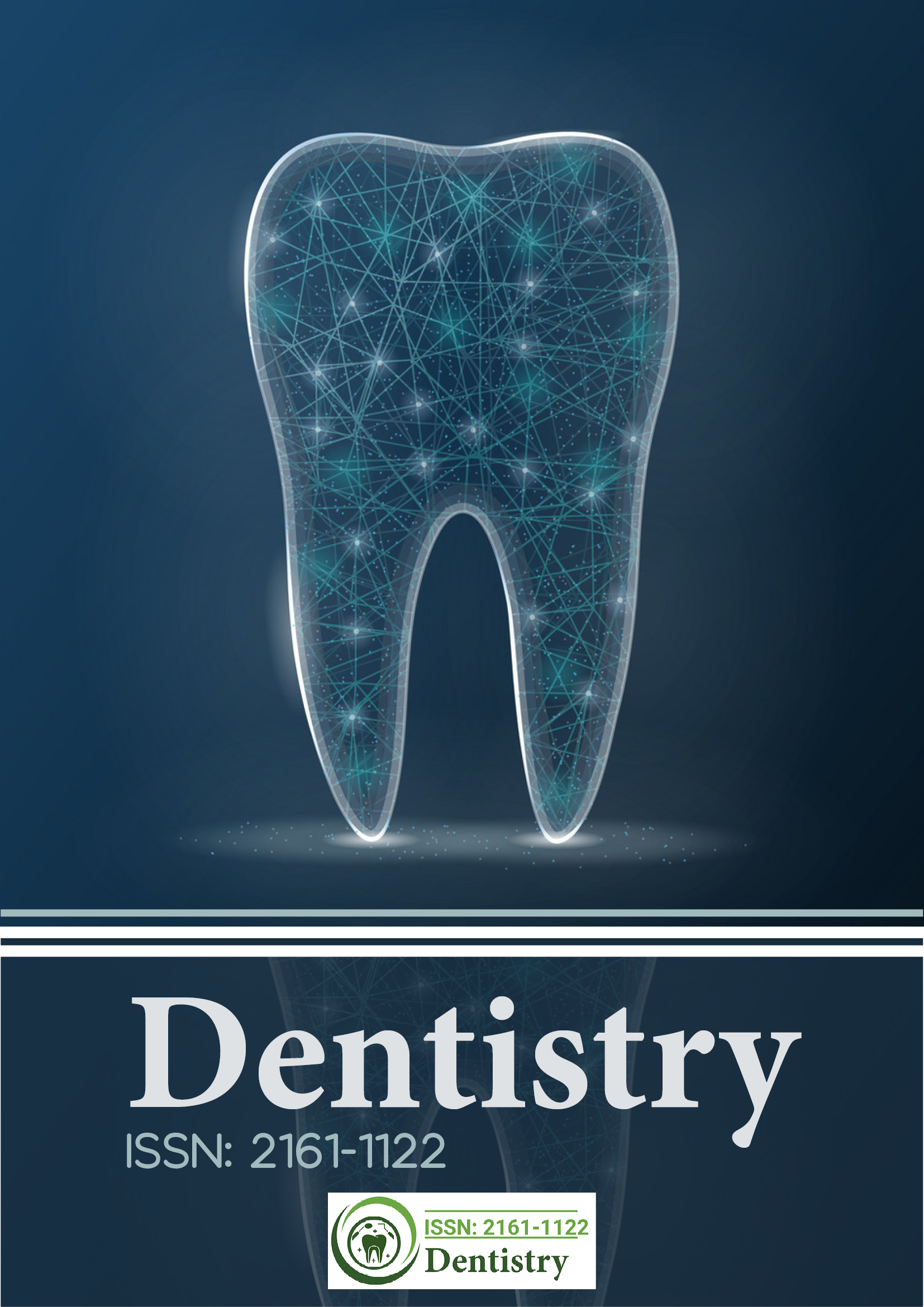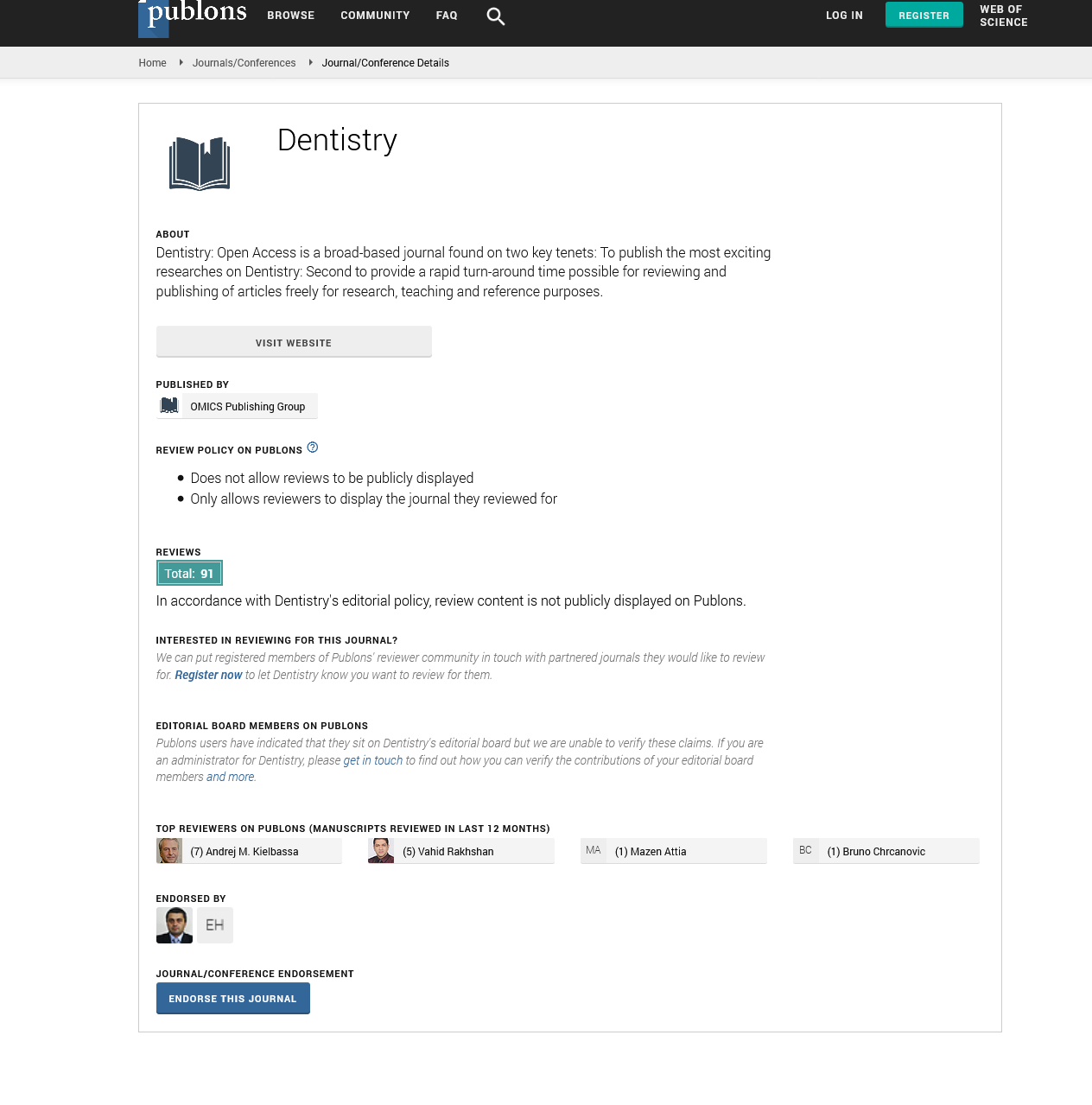Citations : 2345
Dentistry received 2345 citations as per Google Scholar report
Indexed In
- Genamics JournalSeek
- JournalTOCs
- CiteFactor
- Ulrich's Periodicals Directory
- RefSeek
- Hamdard University
- EBSCO A-Z
- Directory of Abstract Indexing for Journals
- OCLC- WorldCat
- Publons
- Geneva Foundation for Medical Education and Research
- Euro Pub
- Google Scholar
Useful Links
Share This Page
Journal Flyer

Open Access Journals
- Agri and Aquaculture
- Biochemistry
- Bioinformatics & Systems Biology
- Business & Management
- Chemistry
- Clinical Sciences
- Engineering
- Food & Nutrition
- General Science
- Genetics & Molecular Biology
- Immunology & Microbiology
- Medical Sciences
- Neuroscience & Psychology
- Nursing & Health Care
- Pharmaceutical Sciences
Commentary - (2025) Volume 15, Issue 2
Surgical Management of a Large Oral Mass under Local Anesthesia
Peter Hansen*Received: 26-May-2025, Manuscript No. DCR-25-29700 ; Editor assigned: 28-May-2025, Pre QC No. DCR-25-29700 (PQ); Reviewed: 11-Jun-2025, QC No. DCR-25-29700 ; Revised: 18-Jun-2025, Manuscript No. DCR-25-29700 (R); Published: 25-Jun-2025, DOI: 10.35248/2161-1122.25.15.726
Description
Oral neurofibromas are benign tumors arising from peripheral nerve sheaths and are commonly associated with neurofibromatosis type 1. While usually small and asymptomatic, massive lesions can cause functional impairment, facial asymmetry and discomfort. Surgical excision is the standard treatment, often performed under general anesthesia. This case report describes the diagnosis, clinical presentation and successful management of a massive oral neurofibroma under local anesthesia. The report emphasizes clinical considerations, surgical technique, patient management and postoperative outcomes.
Neurofibromas are benign neoplasms originating from Schwann cells, perineural cells and fibroblasts. They can occur in various body sites, including the oral cavity. Oral neurofibromas are relatively uncommon and may present as solitary lesions or multiple tumors associated with neurofibromatosis. Large lesions can interfere with mastication, speech and oral hygiene. Early recognition and treatment are essential to prevent complications. Surgical excision remains the primary treatment modality, traditionally performed under general anesthesia for large lesions. This case report demonstrates the feasibility of excising a massive oral neurofibroma under local anesthesia with favorable functional and cosmetic outcomes.
Diagnosis
Based on clinical and radiographic findings, a provisional diagnosis of oral neurofibroma was made. Histopathological examination following excision confirmed a benign neurofibroma characterized by interlacing bundles of spindle-shaped cells with wavy nuclei and a collagenous stroma. Immunohistochemistry demonstrated S-100 protein positivity, supporting neural origin. No features suggestive of malignancy were observed.
Treatment planning
Considering the patient’s preference and the absence of systemic comorbidities, surgical excision under local anesthesia was planned. Preoperative evaluation included routine blood investigations and assessment of coagulation profile. Local infiltration with lidocaine and epinephrine provided adequate anesthesia and hemostasis. The surgical plan prioritized complete tumor removal while preserving adjacent neurovascular structures and minimizing postoperative morbidity.
Surgical procedure
The lesion was approached intraorally, with careful dissection along the tumor capsule. Blunt and sharp dissection techniques were employed to separate the tumor from surrounding muscle and connective tissue. Hemostasis was achieved using cautery and pressure. The excised specimen was sent for histopathological evaluation. Primary closure of the mucosal defect was performed using resorbable sutures. The procedure was completed without complications and the patient tolerated the surgery well under local anesthesia.
Postoperative care
Postoperative management included analgesics, antibiotics and oral hygiene instructions. The patient was advised to maintain a soft diet for one week. Follow-up visits were scheduled at one week, one month and three months to monitor healing, functional recovery and early detection of recurrence. Mild edema and discomfort resolved within a week. Sutures dissolved naturally and complete mucosal healing was observed at one-month follow-up.
Outcome and follow-up
At six-month follow-up, the patient reported normal mastication and speech. Facial symmetry was preserved and no signs of recurrence were observed. Functional outcomes were satisfactory and the patient expressed satisfaction with both aesthetic and clinical results. Continued monitoring is planned to detect any late recurrence, given the potential for neurofibroma regrowth.
Oral neurofibromas are typically slow-growing and lesions exceeding 5 cm in size are considered massive. Surgical excision is the definitive treatment, with general anesthesia commonly preferred for large tumors. However, in selected cases, local anesthesia can be effective, reducing risks associated with general anesthesia and allowing faster recovery. Adequate preoperative planning, precise dissection and careful hemostasis are essential to achieve successful outcomes.
Local anesthesia offers several advantages, including reduced systemic risk, shorter operative time and immediate postoperative assessment of function. Limitations include potential discomfort during surgery, restricted access in posterior lesions and requirement for patient cooperation. Careful selection of cases is therefore essential.
Postoperative monitoring is critical due to the potential for recurrence, especially in patients with neurofibromatosis type 1. Long-term follow-up allows early detection of regrowth and timely intervention. Preservation of adjacent structures and careful closure techniques contribute to favorable functional and aesthetic outcomes.
Massive oral neurofibromas pose challenges in diagnosis, surgical management and postoperative care. While general anesthesia is often considered for large lesions, local anesthesia can provide a safe and effective alternative in selected patients. Complete excision with careful dissection ensures satisfactory functional and aesthetic outcomes. Ongoing follow-up is essential to monitor healing, detect recurrence and maintain oral health.
Citation: Hansen P (2025). Surgical Management of a Large Oral Mass under Local Anesthesia. J Dentistry. 15:726.
Copyright: © 2025 Hansen P. This is an open-access article distributed under the terms of the Creative Commons Attribution License, which permits unrestricted use, distribution, and reproduction in any medium, provided the original author and source are credited.

